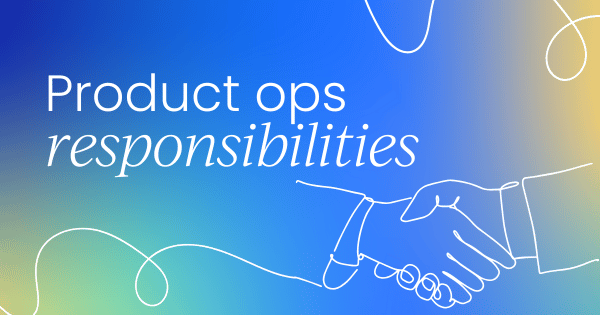Ever feel like you’re the glue holding everything together, but no one quite knows what it is you do? If you’re in product ops, you’re probably nodding your head right now.
Product ops has truly stepped into its own, evolving from a nascent concept to the vital connective tissue within product-led organizations. But with this growth comes a natural question:
What exactly is product ops responsible for in 2025, and where do its boundaries lie?
This article, drawing insights from the State of Product Ops Report 2025, aims to pull back the curtain on just that.
We'll dive deep into the core mandates that define the role today, explore the unique responsibilities of solo product ops professionals, and examine how product ops success is measured.
Get ready to understand your role – and its future – a whole lot better.
The core responsibilities of product ops teams
If you're in product ops, you know your plate is rarely empty. The State of Product Ops Report 2025 confirms what many of you already feel: there are some responsibilities that are almost universally recognized as central to the product ops function. These aren't just "nice-to-haves"; they're the bedrock of efficient product organizations.
Let's start with the big ones, the areas where product ops truly shines and where its value is undeniable.
1. Cross-functional alignment and collaboration
First up, cross-functional alignment and collaboration. A staggering 93% of respondents to our report consider this a core responsibility.
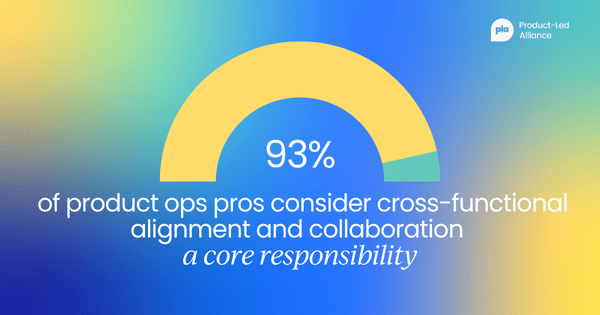
As a product ops pro, you're the bridge-builder, the friction-reducer, the one ensuring that product management, engineering, marketing, customer success, and sales aren't just coexisting but collaborating effectively.
As Graham Reed, Head of Product Operations at HeliosX, aptly puts it,
"Silos are far easier to break down from the outside and best practices can be shared easily."
Without you, it's a free-for-all, and no one wants that.
2. Process optimization and workflow management
Closely following cross-functional alignment and collaboration is process optimization and workflow management, with 90% of practitioners agreeing this is a core duty.
This is where you get to be the efficiency guru, streamlining day-to-day operations and ensuring the product development life cycle runs as smoothly as possible. Think about it: every time a product manager can focus on customer problems instead of wrestling with clunky processes, that's your win.
3. Tool and platform administration
With 81% citing tool and platform administration as a core responsibility, it's clear that product ops plays a vital role in managing the very infrastructure that keeps product development humming.
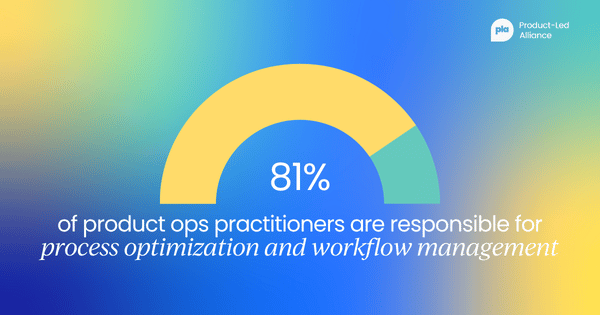
Whether it's Jira, Aha!, ClickUp, or a bespoke system, you're the one making sure these tools aren't just installed, but actually optimized and integrated for seamless use. Our report highlights that workflow management and roadmapping tools are considered the most valuable, underscoring your crucial role in enabling visibility and alignment.
The emerging responsibilities of product ops teams
Beyond the foundational duties, product ops is increasingly taking on responsibilities that deepen its impact and expand its reach. While not common to all product ops functions, these areas are clearly gaining traction.
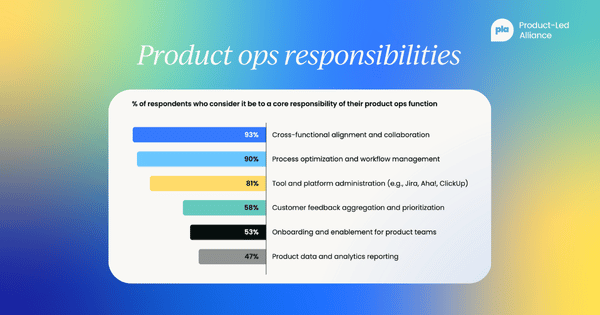
1. Customer feedback aggregation and prioritization
Customer feedback aggregation and prioritization is a significant responsibility for 58% of product ops functions. This is all about ensuring the voice of the customer shapes the roadmap.
This responsibility reflects another key finding from the report: a notable increase in product ops functions being measured on customer retention or churn rates (up from 7% in 2023 to 16% in 2025). This shift reflects a tightening economic landscape where customer-centric metrics are absolutely paramount.
2. Onboarding and enablement for product teams
Our next big responsibility is onboarding and enablement for product teams, a core duty for 53% of respondents. In other words, product ops teams are getting new product managers up to speed, providing the frameworks, tools, and support they need to thrive.
3. Product data and analytics reporting
While less than half (47%) consider it a core function, product data and analytics reporting is a growing area for product ops. Even in organizations with dedicated analytics teams, it’s often product ops folks who are connecting the dots and ensuring data-driven decision-making permeates the product organization.
It's no surprise that 23% of product ops practitioners are excited about advanced data analytics and predictive insights – they’re hungry for smarter, more proactive tooling.
4. Strategic and governance roles
Here's where it gets really interesting. Beyond the day-to-day, many product ops functions are stepping into roles that are decidedly more strategic and governance-focused.
Our report highlights "other responsibilities" like quarterly planning, MBR (monthly business review) and QBR (quarterly business review) reporting, product documentation, release management, roadmap planning, IT governance, and even – gasp! – product strategy.
What does this tell us? It suggests a maturing function that's not just enabling delivery, but actively shaping strategic direction. Product ops is taking on the orchestration of key business processes, acting as the connective tissue between product teams and wider organizational planning cycles.
In larger or more regulated companies, this operational backbone is absolutely essential. You're not just supporting; you're influencing.
The solo product ops pro: A similar but tighter remit
What if you're a product ops team of one? Our report shows that the core responsibilities for solo practitioners largely mirror those of larger teams, though with a slightly sharper focus.
For solo product ops pros, cross-functional alignment and collaboration remains paramount (86%), as does process optimization and workflow management (82%). You're still the central figure, making sure things run smoothly and people work together.
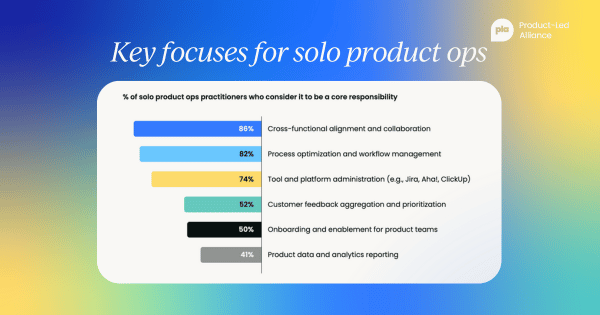
Tool and platform administration is also a significant responsibility (74%), ensuring the tech stack supports efficient operations. However, you might find yourself prioritizing high-impact, cross-team initiatives, leading to a slight drop in ownership for more specialized or time-intensive tasks.
For instance, customer feedback aggregation (52%), onboarding (50%), and especially product data and analytics reporting (41%) all see slightly lower rates of responsibility among solo practitioners.
This suggests that when you're flying solo, you're often delegating or deprioritizing responsibilities that demand deeper specialization or significant time investment, focusing instead on the most critical operational enablement.
Measuring product ops success
So, you're doing all this amazing work – but how do you prove it? Measuring the impact of product ops remains a challenge for many teams. In fact, one in five respondents (21%) admit they have no formal method in place for evaluating their function's success. The good news? That number has dropped by half since 2023, so progress is definitely underway.
Among those who do track efficacy, the focus tends to be on qualitative, team-centric metrics. More than half (54%) use product team satisfaction scores, while 37% rely on ratings of cross-functional collaboration.
This indicates that product ops is still largely viewed as an enablement function, with success measured by how effectively it supports internal teams, drives alignment, and boosts morale and efficiency.
However, there's a notable shift towards more business-centric metrics. Customer retention or churn rates are now used by 16% of Product Ops functions – a significant jump from just 7% in 2023.
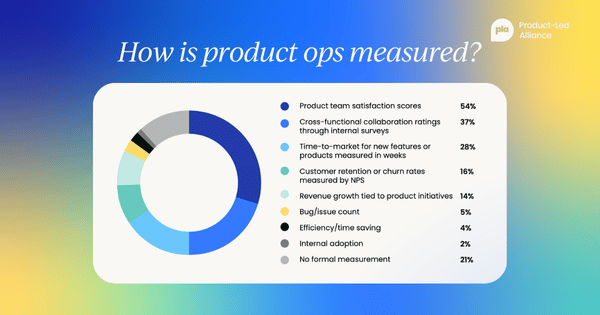
So, if you’re looking to implement metrics for your product ops function, where should you start? Topher Fox, Director of Product Operations at Aerospike, advises:
"When it comes to measuring product ops, start simple. Are product teams making better, faster decisions? Are they spending more time on customer problems and less time wrestling with process or tools?"
Chris Butler, Product Operations Manager at GitHub, adds:
"As you mature, layer in metrics that show the health of your operating system – things like data adoption, consistency in rituals, and alignment across roadmaps. One overlooked but critical metric: retention of product talent."
Ultimately, you're looking to show that your efforts make the product org a place where people can truly thrive.
Conclusion
Product ops in 2025 is a strategic imperative. It's the established, crucial function for internal efficiency, alignment, and the smooth operation of complex product organizations. It's the one making sure the product engine runs, and runs well.
Whether the product ops function is a dedicated team or a solo practitioner, its core responsibilities in process, tools, and internal collaboration are undeniable.
While proving its impact can sometimes feel like an uphill battle, the increasing focus on concrete metrics like customer retention shows that its contributions are becoming more tangibly recognized.
The State of Product Ops Report 2025 makes it clear: product ops is here, it's essential, and it's continuously strengthening its impact.



 Follow us on LinkedIn
Follow us on LinkedIn

